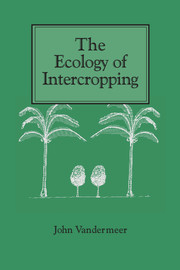Book contents
- Frontmatter
- Contents
- Preface
- 1 Introduction: intercrops and ecology
- 2 The measurement of intercrop performance
- 3 The competitive production principle
- 4 Facilitation
- 5 Mechanisms of the competitive production principle
- 6 The environments modified to produce facilitation
- 7 Special problems in intercrops involving perennials
- 8 Weeds and intercrops
- 9 Variability and intercrops
- 10 Planning intercrops – a phenomenological approach
- 11 Planning intercrops – a mechanistic approach
- 12 Critical research directions for the future
- References
- Author index
- Subject index
12 - Critical research directions for the future
Published online by Cambridge University Press: 05 August 2012
- Frontmatter
- Contents
- Preface
- 1 Introduction: intercrops and ecology
- 2 The measurement of intercrop performance
- 3 The competitive production principle
- 4 Facilitation
- 5 Mechanisms of the competitive production principle
- 6 The environments modified to produce facilitation
- 7 Special problems in intercrops involving perennials
- 8 Weeds and intercrops
- 9 Variability and intercrops
- 10 Planning intercrops – a phenomenological approach
- 11 Planning intercrops – a mechanistic approach
- 12 Critical research directions for the future
- References
- Author index
- Subject index
Summary
The foregoing chapters have summarized some of the research directions currently underway in intercropping research and have indicated some possible simple extensions of relatively routine ecological theory into the realm of intercropping research. The ideas expressed have ranged from the mainly intuitive to the highly quantitative engineering designs of intercropping systems, and have utilized some simple applications of set theory and some not so simple applications of partial differential equations. By and large to this point all material has been well-known on two levels, the level of the ecological theory to be applied and the level of the need for it in intercropping.
In this chapter we briefly consider several topics that are either not so well known as ecological formulations and/or not usually part of the typical research agenda of intercropping researchers. These topics are included here because of what appears to be a great need for their consideration among researchers. Because they are topics more for the future than the present, their presentation will be far more tentative and speculative than the rest of the material in the book has been.
Dynamic plant growth and interaction models
A situation in which the need for a dynamic approach is essential was presented in Chapter 10. The use of a static yield–density approach when applied to a system of tomatoes and beans resulted in excellent predictions some of the time.
- Type
- Chapter
- Information
- The Ecology of Intercropping , pp. 189 - 203Publisher: Cambridge University PressPrint publication year: 1989



